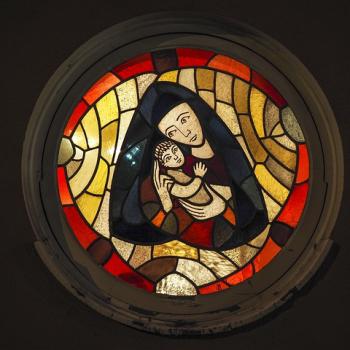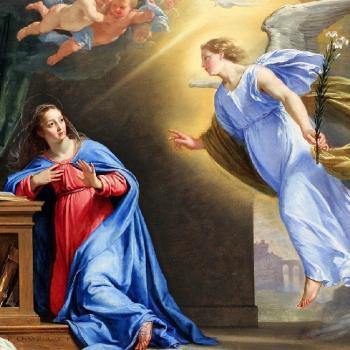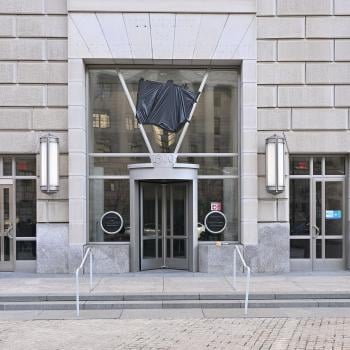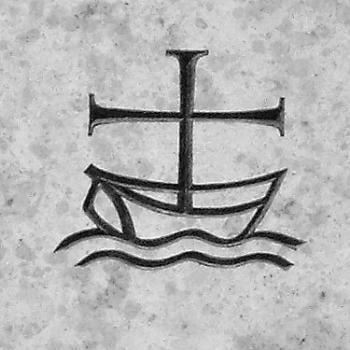
Holy Week (sometimes called “Great Week” or “Passion Week”) is an 8-day period—from Palm Sunday to Easter Sunday—commemorated each year, particularly in the High Church Christian traditions of Roman Catholicism, Eastern Orthodoxy, Anglicanism/Episcopalianism, and by some Lutherans and Methodists. Because Easter is the holiest time in the Christian liturgical calendar, Holy Week provides an opportunity for practitioners of the faith to reflect on their personal sinfulness and their need for Christ (and His sacrifice on their behalf). The historic events commemorated each year (during Holy Week) symbolically represent a transition in the human condition. Whereas Adam and Eve provoked a fall, by which all people have become sinful and estranged from their God; Jesus (through the events of this sacred week) reversed the effects of the fall, making it possible for all to return to God.
For Christians, many of the messianic prophecies of the Hebrew Bible (or “Old Testament”) were fulfilled during the last week of Jesus’s life. For example, Palm Sunday appears to be foreshadowed by Zechariah 9:9; Judas Iscariot’s betrayal of Jesus is often seen as a fulfillment of Zechariah 11:12 & Psalm 41:9; the abuse and torture Jesus endured the last couple of days of His life are believed to be prefigured by the words of Isaiah 50:6 & 53:1-12; and Christ’s crucifixion is understood to have been predicted by Zechariah 13:6 & Psalm 22:16. Many passages of the Hebrew Bible were seen by the early Christian Church as prophetically foreseeing the life and death of Christ, and detailing the events commemorated during Holy Week. (See also Psalm 22:1, 7-8 & 18; Exodus 12:46; Numbers 9:12; Isaiah 25:8-9.)
Each of the days of Holy Week have special significance, inviting the believer to see more deeply into the selfless life of Jesus Christ, and to sense His love and grace—as manifest in His crucifixion, and as culminated with His resurrection (on what has become known as “Easter Morn”).
Palm Sunday
As the official beginning of Holy Week, Palm Sunday commemorates Jesus’s “Triumphal Entry” into Jerusalem (Matthew 21; Mark 11; Luke 19; John 12)—sitting on the back of a donkey, fulfilling the prophecy of Zechariah 9:9 (“Rejoice greatly, O daughter of Zion; shout, O daughter of Jerusalem: behold, thy King cometh unto thee: he is just, and having salvation; lowly, and riding upon an ass, and upon a colt the foal of an ass.”). This first day of Holy Week is called “Palm Sunday” because, in commemoration of how Jesus’s followers strewed His path with palm branches (Matthew 21:8; Mark 11:8; John 12:13), many Churches give out palm fronds (sometimes formed in the shape of a cross) to those in attendance—as a means of remembering Christ throughout the year. (It is the leftover palm fronds that are burned nearly one year later to make the ashes for “Ash Wednesday”—the traditional beginning of the Lenten season.) Palm Sunday reminds Christians that, while there may be many political leaders during their lifetimes, the true Christian allows Christ to be the King of their lives; the one who must rule every aspect of their mortal existence.
Holy (or Great) Monday
Jesus and some of His disciples spent Sunday night in Bethany. As they traveled the next day, they saw a fig tree full of foliage—a sign that the tree would be full of ripe figs. However, when they got close to the tree, they saw that it had no fruit on it; and, so, Jesus “cursed” the tree, which ultimately caused it to wither and die. In antiquity, the fig was sometimes seen as a symbol of Israel, or God’s covenant people. Thus, Jesus’s cursing of the tree implied His rejection of those who put forth “signs” of their covenant status (or relationship with God), but who actually bore no fruit, as the faithful should if they were attempting to follow God. Thus, after cursing the fig tree, Jesus went to the temple (on Holy Monday) and cast out the merchants, “thieves” and “robbers” (Matthew 21:12-13; Mark 11:15-17. See also Luke 19:45-46) who epitomized the fruitless people of the covenant through their feigned religiosity. Just as the tree died because of its lack of fruitfulness, Jesus sought to symbolically remind us that a life of feigned devotion, void of Christian fruits, will lead to spiritual death.
Holy (or Fig) Tuesday
On this third day of Holy Week, a number of events are commemorated—including a number of teachings Jesus delivered that Holy Tuesday. For example, Matthew describes the fig tree as withering upon being cursed (Matthew 21:19-20). However, Mark records that it was on Tuesday that Jesus and His disciples passed by the same tree a second time and, at that point, noticed that it had miraculously “dried up from the roots” (Mark 11:20). Jesus then gave the first discourse for the day, highlighting the importance of having “faith in God” and “not doubt[ing]” in one’s “heart.” It was during this discourse that Jesus famously taught His disciples that, if their faith was sufficient, they could move “mountains” (Mark 11:22-23). It was also on Holy Tuesday that Jesus taught the “chief priests and the scribes” in the Temple—prophetically making it clear to them that He knew that they would seek to slay Him (Luke 20:9-19). Through this interaction, the lesson of the cursed fig tree was evident. Those who were said to be the leaders of the faith were shown to not be brining forth good fruits. Later, on His way back to Bethany, Jesus stopped on the Mount of Olives and gave His “Olivet Discourse” (Matthew 24-25; Mark 13; Luke 21), where he warned His disciples of trials they would soon face—trials which would determine if they too were fruitless trees or devoted disciples. Finally, as one more example of spiritual barrenness, it was on the night of “Holy Tuesday” that Judas began His formal betrayal of Jesus, approaching the Sanhedrin, and asking them, “What will ye give me, [so that] I will deliver him unto you?” (Matthew 26:15. See also Mark 14:10-11; Luke 22:3-6).
Holy (or Spy) Wednesday
This fourth day of Holy Week if often called “Spy Wednesday” because it is believed to be the day on which the high priest and authorities formally hatched their plot to take Jesus’s life. This day is believed to be the last peaceful day of Jesus’s mortal life. He spent that Wednesday in Bethany, knowing that, on the morrow, “all hell would” quite literally “break lose.”
Maundy Thursday
The fifth day of Holy Week is known as “Maundy Thursday,” from the Latin term for “command,” “commandment,” or “mandate.” It was on this sacred day, just prior to Jesus being treated with the utmost hatred, that He said to His disciples, “A new commandment I give unto you, that ye love one another; as I have loved you, that ye also love one another. By this shall all people know that ye are my disciples, if ye have love one to another” (John 13:34-35). Once again, the message of the cursed fig tree is alluded to; true disciples live loving lives, as Christ loved. They do not hate, as the authorities of Jesus’s day hated Him. During the “Last Supper,” which took place on Maundy Thursday, Jesus instituted the Sacrament of the Lord’s Supper (or holy communion) and washed the feet of His apostles. Thus, on this day of Holy Week, many Christian Churches administer Holy Communion, and several traditions also engage in the rite of “washing of the feet”—a symbol of loving as Jesus loved. It was on the eve of Maundy Thursday that Judas left the Passover dinner (being celebrated by Jesus and His apostles) to lead Christ’s captors to Him. It was that night that Jesus entered Gethsemane’s garden and, according to Luke, “being in an agony…prayed more earnestly: and his sweat was as it were great drops of blood falling down to the ground” (Luke 22:44). It was also on Holy Thursday that Jesus was arrested and taken to the house of the high priest, where the Sanhedrin would convene to condemn Him. Within hours, Peter would utter his famous denial regarding his affiliation with Jesus (Matthew 26:34 & 74-75; Mark 14:30 & 66-72; Luke 22:34 & 60-62; John 13:38 & 18:25-27).
Good Friday
This sixth day of Holy Week has the most unexpected of names—“Good Friday.” On this day, which commemorates the incomprehensibly violent death of Jesus (through scourging and crucifixion), the worst thing possible happened to the greatest being that ever lived. Jesus’s ransom sacrifice for sin happened on Good Friday, leading to His resurrection on Sunday. Thus, while most terrible for Him, we refer to it as “Good Friday” because of what it has done for us. Christ’s death brought only good; and made possible the eternal destruction of all that is evil. On this day, Jesus was arraigned before Annas, the Sanhedrin, the Roman authorities—Pilate, then Herod, then again before Pilate (See Mark 14; Luke 22; John 18). He was questioned, beaten, scourged, mocked, crucified, and pierced with the soldier’s spear. It was on this day that His body was hurriedly prepared and placed in the tomb—as the Sabbath would begin at sundown. In commemoration of all this, it is common for some Christians to fast on Good Friday and, in Roman Catholicism, none of the sacraments are traditionally “celebrated”—with the exception of penance and anointing the sick (or baptism for someone in danger of death)—because this day is a time to mourn, not “celebrate.”
Holy (or Black) Saturday
The seventh day of Holy Week is often referred to as “Black Saturday” because black is the color which symbolizes death and mourning—and it is on this day that Jesus’s body lay dead in the tomb while His disciples grieved His passing. In all high church traditions, the focus of this portion of Holy Week is on mourning the death of Christ; and customs associated with grieving are typically observed. On this day, in Eastern traditions, a funeral is held for Jesus, and a tomb is created, in which an image of Christ is placed, and it is carried in a procession around the Church. In Western traditions, the altar is traditionally stripped bare, and the celebration of sacraments is limited on Black Saturday. (On this day, Holy Communion is reserved for only the dying.) In some Anglican, Lutheran and Methodists Churches, the altar is draped in black on this seventh day of Holy Week.
Easter Sunday
This last day of Holy Week is the most important, and the most celebratory. It is the climax of Holy Week, but also the climax of the Lenten season and of the Christian liturgical calendar. All the problems incident to the mortal experience are believed to be resolved in the events commemorated on this day. Jesus is risen. Sin has been overcome, and death is no more. As the apostle Paul rhetorically asked (in his famous text on the resurrection), “O death, where is thy sting? O grave, where is thy victory?” (1 Corinthians 15:55). It was on this day that the tomb was found empty. And on this day, in the modern era, Christians commemorate the reality that the resurrected Jesus appeared to Mary Magdalene first (Mark 16:9; John 20:11-18), then to others, including to a group of female disciples (Matthew 28:5-10), to Cleopas and another disciple on the Road to Emmaus (Luke 24:13-35), to Peter (Luke 24:33-34), and to ten of His twelve apostles (Luke 24:36-43; John 20:19-23).
While not all Christians commemorate Holy Week, the events which mark the various days of this 8-day period are literally at the heart of the Christian message. Jesus is the focus, sin saturates our world, the devil reigns in the hearts of many, persecution and death are inevitable, but Christ can and has overcome all things. Whether or not one is part of a tradition that commemorates the 8-days of Holy Week, each Christian should keep in their remembrance (throughout the year) the foundational teachings of this sacred season—and seek to bring forth the “fruits” of true discipleship. That is largely the message of Holy Week.
To learn more about Christianity, click here.3/23/2021 6:32:39 PM









